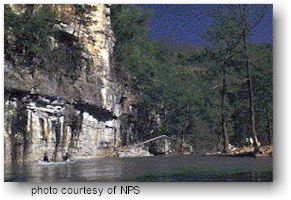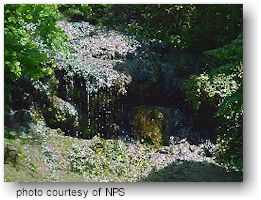


|

|
 Buffalo National River |
 Hot Springs cascade at Hot Springs National Park |
| Arkansas
Post National Memorial - In 1686, Henri de Tonti
established a trading post known as "Poste de Arkansea" at the
Quapaw village of Osotouy. It was the first semi-permanent French
settlement in the lower Mississippi River Valley. The establishment of
the Post was the first step in a long struggle between France, Spain,
and England over the interior of the North American continent.
Buffalo National River - The Buffalo River is one of the few remaining unpolluted, free-flowing rivers in the lower 48 states offering both swift-running and placid stretches. The Buffalo National River encompasses 135 miles of the 150-mile long river. It begins as a trickle in the Boston Mountains 15 miles above the park boundary. Following what is likely an ancient riverbed, the Buffalo cuts its way through massive limestone bluffs traveling eastward through the Ozarks and into the White River. The national river has three designated wilderness areas within its boundaries. Central High School National Historic Site - Little Rock High School, now Central High School National Historic Site, is a national emblem of the often violent struggle over school desegregation. Trail Of Tears National Historic Trail - In 1838, the United States government forcibly removed more than 16,000 Cherokee Indian people from their homelands in Tennessee, Alabama, North Carolina, and Georgia, and sent them to Indian Territory (today known as Oklahoma). The Trail of Tears National Historic Trail commemorates the removal of the Cherokee and the paths that 17 Cherokee detachments followed westward. Today the trail encompasses about 2,200 miles of land and water routes, and traverses portions of nine states. |
Fort
Smith National Historic Site - Fort Smith National
Historic Site embraces the remains of two frontier forts and the Federal
Court for the Western District of Arkansas. Commemorating a significant
phase of America's westward expansion, it stands today as a reminder of
80 turbulent years in the history of Federal Indian Policy.
Hot Springs National Park - People have used the hot spring water in therapeutic baths for more than two hundred years to treat rheumatism and other ailments. The reservation eventually developed into a well-known resort nicknamed "The American Spa" because it attracted not only the wealthy but also indigent health seekers from around the world. Today the park protects eight historic bathhouses with the former luxurious Fordyce Bathhouse housing the park visitor center. The entire "Bathhouse Row" area is a National Historic Landmark District that contains the grandest collection of bathhouses of its kind in North America. Pea Ridge National Military Park - Pea Ridge National Military Park is a 4,300 acre Civil War Battlefield that preserves the site of the March 1862 battle that saved Missouri for the Union. |
|
|
|
For more information visit the National Park Service website |
|||